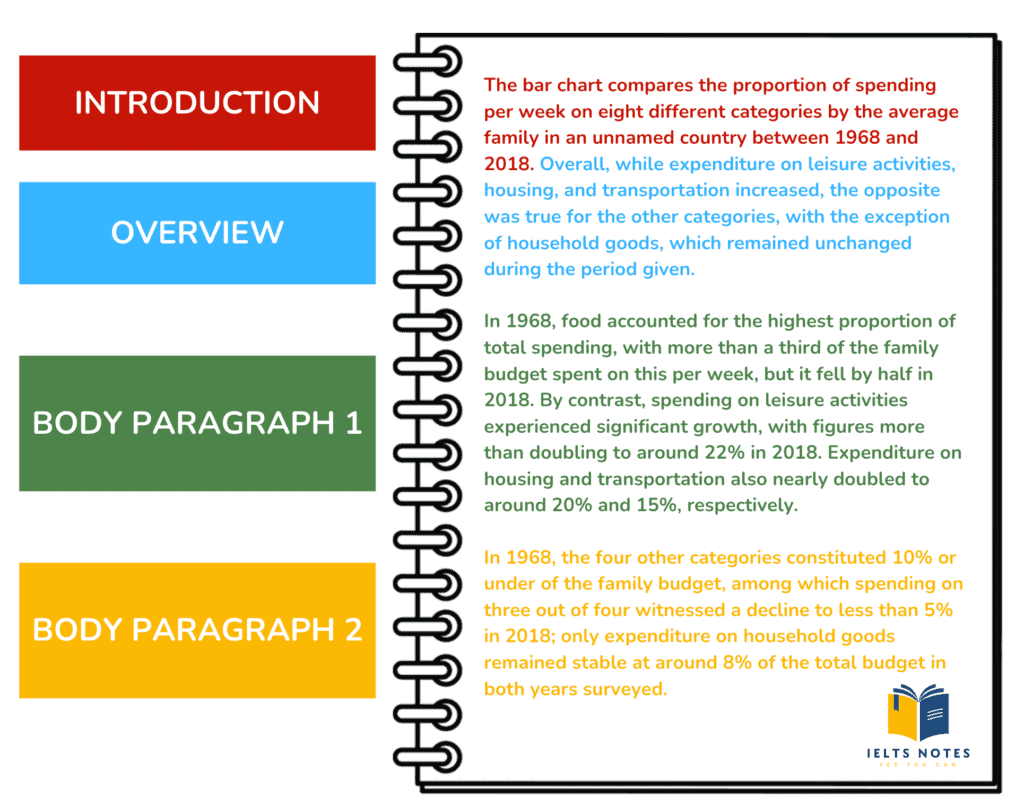Preparing for the IELTS Writing test can be daunting, but with the right strategies and resources, you can achieve your desired band score. This ultimate guide will equip you with practical tips and tricks to excel in both IELTS Writing Task 1 and Task 2.
Task 1: Overview
In Task 1, you’ll be presented with a line graph, bar chart, map, table, or diagram, and your task is to describe and summarize the information. The key skills being tested are your ability to:
- Identify the main features and trends.
- Provide an accurate and concise summary using clear and formal language.
- Organize your response logically within at least 150 words.
Question types

- Line Graph: shows trends or changes over time.
- Bar Chart: compares different categories using vertical or horizontal bars.
- Pie Chart: highlights proportions or percentages of a whole.
- Table: presents data in rows and columns for easy comparison.
- Multiple graphs/charts: refer to questions that feature more than one graph
- Process/Diagram: explains the steps in a process or how something works.
- Map: demonstrates changes in geographic areas over time or differences between locations.
Time Management for Task 1
You should spend 20 minutes on Task 1 because it’s worth 1/3 of your total score. Use this time wisely:
- Spend 3-4 minutes analyzing the visual and planning your response.
- Dedicate 15 minutes to writing.
- Use the remaining time to proofread for grammar, spelling, and clarity.
IELTS Writing Task 1 Structure

A strong Task 1 response follows a clear and logical structure, typically divided into four paragraphs:
- Introduction: paraphrase the question
- Overview: highlight main trends or patterns
- Body paragraph 1: specific details
- Body paragraph 2: specific details
10 Tips for IELTS Writing Task 1
TIP 1: Understand the Task Requirements
Focus on describing and summarizing key features of the graph, chart, map, or diagram. Avoid giving opinions or reasons.
TIP 2: Paraphrase the Question Prompt
Start your answer by rephrasing the task statement to show a variety of vocabulary and grammar.
TIP 3: Highlight Key Features
Identify and mention the most significant trends, changes, or comparisons, rather than describing everything in detail.
TIP 4: Use a Clear Structure
Stick to a simple format:
- Introduction (paraphrase the question).
- Overview (highlight main trends or patterns).
- Body Paragraph 1 (specific details).
- Body Paragraph 2 (specific details).
TIP 5: Write a Strong Overview
Summarize the main trends or features in one or two sentences without giving specific data.
TIP 6: Use a Variety of Vocabulary
- Use synonyms and a range of words to describe trends (e.g., “increase” → “rise,” “decline” → “drop”).
- Include linking words (e.g., “while,” “whereas,” “similarly”).
TIP 7: Use Units of Measurement Correctly
Mention units like percentages, millions, or kilometers accurately, as they are essential to interpreting the data.
TIP 8: Use the Right Tense
Pay attention to the time frame (e.g., past, present, or future) in the question and use the appropriate verb tense throughout your answer.
TIP 9: Avoid Personal Opinions
Stick to objective descriptions; your task is to report, not interpret or speculate.
TIP 10: Practice Time Management
Spend about 20 minutes on Task 1 and leave time to review your work for grammar, vocabulary, and structure.
Common Mistakes to Avoid
- Ignoring Task Requirements: Always answer all parts of the question.
- Writing Less than the Word Count: Task 1 requires 150 words, and Task 2 requires 250 words. Falling short can hurt your score.
- Using Informal Language: Stick to formal academic language.
- Weak Grammar and Spelling: Proofread your work to avoid simple errors.
- No Overview in Task 1: Always include a clear summary of the key trends.
Top Resources for IELTS Writing Preparation
- Official IELTS Practice Materials: Get familiar with authentic test questions.
- Cambridge IELTS Books: Practice with past exam papers.
- Online Tools: Websites like ieltsnotes.com offer free tips and practice tests.
- YouTube Channels: Check out Youtube IELTS Notes for video tutorials and expert advice.
Final Thoughts
Achieving a high band score in IELTS Writing requires consistent practice and a solid understanding of the test’s expectations. Use these tips and tricks to sharpen your skills and approach the test with confidence. Remember, practice makes perfect!
Good luck with your IELTS Writing preparation!
